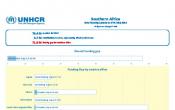Angola
Operation: Angola
Location
{"longitude":18,"latitude":-12,"zoom_level":0}
Latest update of camps and office locations 13 Jan 2016. By clicking on the icons on the map, additional information is displayed.
Key Figures
| 2015 end-year results | |
| 161 | people of concern who received shelter and food support |
| 4,639 | former Angolan refugees assisted to return home |
| 738 | refugees and officials who received training on international refugee protection issues |
| 110 | refugee children issued with a birth certificate |
Latest Updates
People of Concern
16%
Decrease in
2015
2015
| 2015 | 50,337 |
| 2014 | 59,970 |
| 2013 | 45,488 |

[["Refugees",15555],["Asylum-seekers",30143],["Returned refugees",4639]]
Loading ...
Budgets and Expenditure for Angola
< Back
2015
{"categories":[2012,2013,2014,2015,2016],"budget":[9.84500068,4.69733169,5.76081952,5.45305636,3.73148992],"expenditure":[6.14939035,3.58025033,4.43620524,3.08539954,null]}
{"categories":[2012,2013,2014,2015,2016],"p1":[9.84500068,4.69733169,5.76081952,5.45305636,3.73148992],"p2":[null,null,null,null,null],"p3":[null,null,null,null,null],"p4":[null,null,null,null,null]}
{"categories":[2012,2013,2014,2015,2016],"p1":[6.14939035,3.58025033,4.43620524,3.08539954,null],"p2":[null,null,null,null,null],"p3":[null,null,null,null,null],"p4":[null,null,null,null,null]}
Loading ...
CHOOSE A YEAR
- 2015
- 2016
Working environment
- The political situation in Angola remained stable throughout 2015. However, the country’s economy was impacted by the fall in global oil prices. The Government is concerned about irregular movement of people through the country, contributing toward a restrictive protection environment.
- Refugees and asylum-seekers reside mostly in urban areas and enjoy freedom of movement and the right to work. In June 2015, Angola adopted a new asylum law condoning the detention of asylum-seekers, restricting their freedom of movement and right to work. Transitional measures and implementation regulations are not yet in place, and a new refugee status determination (RSD) body has not yet been established, affecting the status of more than 30,000 asylum-seekers.
- The voluntary return programme for former Angolan refugees was concluded at the end of September.
Population trends
- There were 50,337 people of concern (PoC) living in Angola (15,555 refugees and 30,143 asylum-seekers). Refugees mainly originated from Côte d’Ivoire, the Democratic Republic of the Congo (DRC), Rwanda, Sierra Leone, Somalia and Sudan. More than 4,600 former Angolan refugees were assisted with their voluntary return to Angola mainly from the DRC.
Achievements and impact
- UNHCR continued to advocate for sessions of the Angolan refugee status determination body, COREDA, to take place. In 2015, 14 sessions were conducted and 1,022 cases adjudicated. The decisions were improved with an increased focus on analysis of updated country-of-origin Information. COREDA was dissolved in June 2015, following the adoption of the new asylum law that envisages the establishment of a new national eligibility committee.
- A multi-sectorial Working Group was established to address the invocation of cessation of status for the Liberian, Rwandan and Sierra Leonean refugees. Local integration measures are being considered.
- UNHCR, through a partner, was able to gain access to the immigration detention facility and monitored to ensure that PoC were not detained.
- Trainings on SGBV and refugee law for PoC, law enforcement personnel and local authorities were conducted in various provinces in partnership with the Ministry of Family and the Promotion of Women, as well as the national immigration service.
Unmet needs
- UNHCR was not able to assist refugees in obtaining access to higher education or secondary education.
- Training activities on protection and SGBV, in particular in border provinces, require significant additional funding.
- UNHCR was only able to provide legal and social assistance to a limited number of vulnerable PoC.


